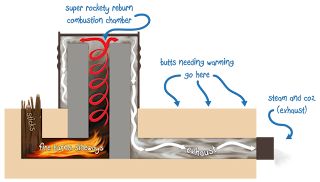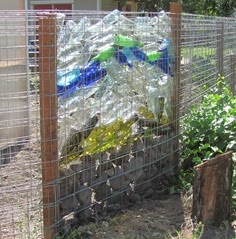Have you ever picked up a rotting log and had it crumble in your hand? Found an old wood pile left to rot? You tried to find some good wood in there but mainly found spongy funk? Yes?! Then you are going to get this right away.
That rotting wood is the start of your new garden, it's soil in the making! The base you are going to start with, is wood.
You begin looking for...Logs, branches, leaves & twigs. Some of us have a lot of them. Some of us don't. In the latter case you look for..rotting untreated lumber, fallen fences, storm ravaged wood wreckage, anybody's unwanted burn pile. You can turn this type of unwanted, clean untreated woody "waste" into a self feeding self watering planting area, with even very poor soil.
The idea is old as the woods quite literally. Hugel means hill or mound in German and combined with the word culture-kultur ( nearly the same in both languages) it describes these log and branch filled mounds.
The basic idea is you lay out large wood pieces logs stumps, branches etc. and cover it well with a bunch of, compost, leaves, wood-chips what ever you have. Then cover very very well with soil, and plant right away. Read on...
What happens is over the years all that wood is rotting and becoming the perfect combination of spongy and airy...a beneficial environmental cocoon deep inside capable of holding water from winter rains for months and months.
Warmth from the pile inside rotting gives extra protection from cold, extending your growing
season.
 |
| Sepp Holzer Illustration |
Garden below demonstrates this, these cucumber seeds were sown the same day from the same seed packet. The added warmth helped quite a bit.
This was a first year side by side experiment..done by one of my readers on Facebook. Right is piled up small wood waste, pine cones and pine bark, covered with soil and compost then with burlap. It was then planted into. The plot on the left side got the same amount of compost at planting. Left side was watered, right side was not, but for one spring rain shower over night! This is one month of growth. Showing that even small piles offer warmth benefits, and good results.
First off..I know many people are saying now.."won't the wood rob nitrogen?" The answer to that is; That's why most say these are best after the 2nd year. So some folks add manure to speed up the process. I like to point out that the pile should be very well covered, covered deep enough in dirt to grow first year. Nitrogen fixing plants are used as an important part of the polyculture planting recommended, and should not be skipped.
Cedars, Redwood types, Madrone, are not the very best choices because they are known not to rot and have properties that are unhealthy to plant growth. That said they can be used in small amounts or around edges of pile as a border if desired.
Soft woods ..Cottonwood, Apple, Pear, Alder, Maple, Oak. Yes..Pine, Fir tho acid at the start are okay if dead for a few years. Some choose it to plant acid loving bushes like blueberry.
Hard woods just don't break down and are valuable for other uses like building furniture or firewood. Dead brambles, Wild roses, Trees or bushes that root easily from cuttings like willow should be dried out completely before being buried unless you are trying to make a willow fence! I have heard it suggested to burn willow or other questionable wood down to bio-char if you are in a rush. This can be added to a hugel.
More about good wood and bad wood at Permies forum
https://www.permies.com/t/12206/hugelkultur/Hugelkultur-Good-wood-Bad-wood
Get a backhoe or digger to match your needs. For the lowest footprint;
Hire local professional with references
Use local materials
Make sure work is planned out
make sure digger understands what you need before you begin, they will not hear you when driving.
finish the job to avoid return visit
fix mistakes right away
stay with operator until job is finished, don't walk away!
You want your wood configured on a nicely leveled out spot and at a right angle to flow of water if built on a slope/hill or against the prevailing wind.
Wood can be placed in a shallow trench, wherever you are working your spot should be level to a max 3 degree variable on a flat spot or terrace. Swales are dug around perimeter as a border for slowing run off, controlling erosion and allowing water to slowly seep in.
Experienced builders with room to do so, recommend building them TALL 7-10 ft. These will support a food system for many, many years!
Any size works and can be scaled down to fit a small yard too, like here
stack wood nice and neat
Sepp Holzer told us to try to achieve a 70 degree slope for the easiest harvesting on tall beds.
You may mix in composted manure, compost, sod turned over.. but it is recommended to use native or natural soil and not to use a potting type blend. Clay content is fine, and in fact helpful for holding moisture. The wood will become compost in time. Hugelkultur is wonderful for breaking up clay soils and making them fertile.
The final steps are as important as building the hill, a polyculture planting is recommended.
When you are all covered with soil, sprinkle with straw then find leafy branches and stand them up against the beds. You will then need to make large wooden pins out of branches as well and pin down the branches tightly against it's surface.
Shown here in Paul Wheaton's great new video!
Use like a spike with crotch pinning down the branches you laid on the surface.
 |
| look for sticks that have one long end and a shorter crooked branch, long end goes into pile while side branch hlds down shade branches. |
These branches pinned on the outside of the pile offer benefits like support, shading, breaking hard rainfall, & reducing erosion until roots form a netting. Mulch pathways well.
This must be planted right away. Large seeds are placed by hand, potato, beans, sunflowers, peas. Small seed mix is made from lettuces, greens of all kinds & root vegetables of all kinds. Lupine, purslane, and beneficial flowers like calendula, nasturtium, feverfew, etc... here and there in a separate mix. The size of the seed affects the way it is broadcast, and you do want a fine even spray of seed to go all over the pile.
Either water very lightly for a few days or let the rain do it for you, settling and shifting will occur, holes can just be filled with soil and patted into place.
The time of year you decide to build your pile, will affect how often you need to water during it's first years.
If you build in the fall before your rainy season, plant with winter vegetables suitable to your climate and/or plant a cover crop. A bed that has had all winter to store water will need very little water or none at all depending on your climate and summer rain fall. A hugelkultur built in spring will need water it's first year most likely. However it will use much less if planted as instructed. No bare soil, a green carpet is best. Mulch is good but still expires moisture with out leaves to catch humidity and send it back to soil and plants. Harmless weeds and herbs such as chickweed and scarlet pimpernel, miners lettuce, docks, purslane, clovers should all be allowed to fill in empty spots and cradle vegetables with moisture and shaded soil. Varied root depths draw moisture from deep inside to the upper layers like stairs.
A wonderful blog with great illustrations
At the Krameterhof, Sepp Holzer's farm in Austria.
built by Sepp Holzer and his Team!
Many images and my base information drawn from this article;
and my time spent with Sepp Holzer during a 5 day workshop, the first of many to come.
All roads lead to
when you want in depth info or if you'd like to read about dozens and dozens of gardens that have been built with this method
PART 2..
Hugelkultur...I did it my way!!
a continuing journey into creative applications.































.JPG)






